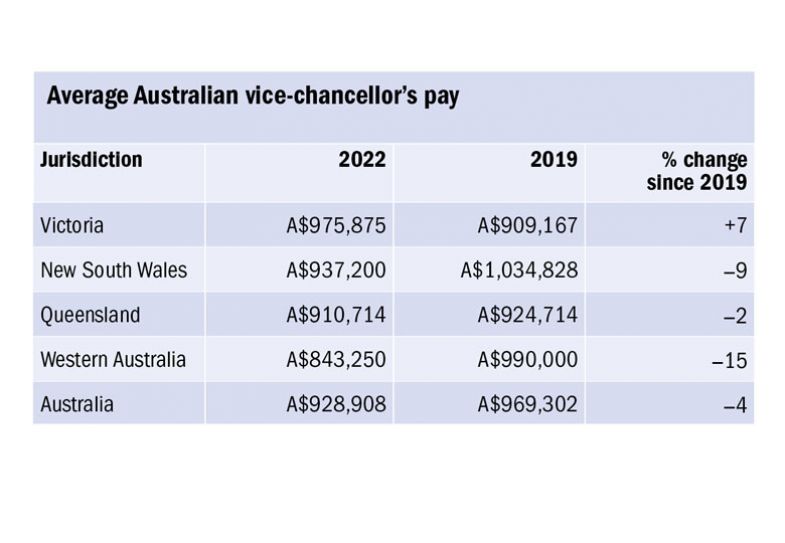Australia’s university sector has pressed pause on the rise in vice-chancellors’ salaries, with Covid-19 interrupting the emergence of a seven-figure norm.
But sector leaders remain extremely well paid by global standards, with over a dozen raking in more than A$1 million (£523 million) each.
A Times Higher Education analysis of university accounts has found that executive remuneration switched into neutral gear in 2022 after declining over the previous two years. Average pay packets rose just A$827 to A$928,908 last year – over A$40,000 less than in 2019.
The analysis covers all public university financial accounts released so far, with four yet to publish their annual reports at the time of writing. The analysis also includes two non-government universities that disclose their leaders’ salaries.
Early in the pandemic, an evaluation of the accounts of all public universities concluded that the average vice-chancellor’s salary had risen over A$1 million in 2019. Since then, salaries have been forced downwards by pandemic-induced austerity that saw many university executives relinquishing bonuses and accepting temporary pay cuts.
Nevertheless, 13 of the vice-chancellors included in the analysis earned A$1 million-plus packages in 2022, compared with 12 in 2019. The University of Melbourne’s Duncan Maskell remained Australia’s best-paid university chief, with reported earnings of more than A$1.5 million – a figure that includes superannuation and a A$300,000 housing “fringe benefit”.
Many vice-chancellors have official university residences used regularly for functions and promotions, with the estimated annual value included in their reported earnings, along with official cars, leave entitlements and other benefits.
Monash University’s Margaret Gardner was the second best-paid vice-chancellor, receiving about A$1.375 million. While the new vice-chancellors of the University of Sydney and UNSW Sydney earned several hundred thousand dollars less than their predecessors, both pocketed pay packets of about A$1.1 million.
A recent report noted that the average vice-chancellor earned almost twice as much as the prime minister, who had “arguably the most important job in the country”, with four in five surveyed respondents saying university bosses should not earn more than the national leader. The prime minister receives a base salary of A$564,356 plus residences, superannuation and tens of thousands of dollars in allowances.

Economist and policy analyst John Howard said vice-chancellors earned similar amounts to civil service leaders, and the typically less generously remunerated prime minister was a “ridiculous” comparator.
“Vice-chancellors run multibillion-dollar enterprises and businesses,” Dr Howard said. “They’re responsible and accountable for the performance of the university, and they compete with about 40 domestic counterparts and thousands more overseas. The prime minister doesn’t compete with anyone, and he has 23 ministers, who are jointly and separately accountable for the results of the government, to help him out.”
The THE analysis found that Victorian university bosses earned an average of A$975,875, 7 per cent more than in 2019. Average pay packets had declined by 2 per cent in Queensland, 9 per cent in New South Wales and 15 per cent in Western Australia.
More than half the country’s universities have changed leaders since the pandemic’s onset, with a rash of payouts and installations of interim vice-chancellors complicating calculations of average remuneration – particularly in 2020, when the heads of 16 universities resigned or announced that they were leaving.
Some vice-chancellors donate portions of their income to scholarship or hardship funds – a practice that escalated during the pandemic. The University of Tasmania’s Rufus Black gave away A$100,000 in each of the past two years.
Register to continue
Why register?
- Registration is free and only takes a moment
- Once registered, you can read 3 articles a month
- Sign up for our newsletter
Subscribe
Or subscribe for unlimited access to:
- Unlimited access to news, views, insights & reviews
- Digital editions
- Digital access to THE’s university and college rankings analysis
Already registered or a current subscriber? Login









